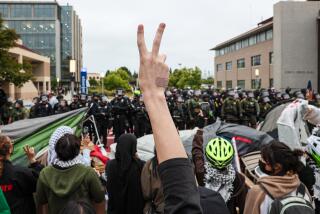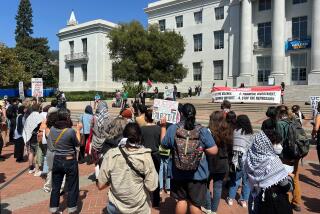Column: A reminder: Anti-communist hysteria almost destroyed the University of California
A bill making its way through the California Legislature to remove membership in the Communist Party as a disqualification for employment by the state — 64 years after the rule was imposed — prompts us to revisit how anti-communist hysteria in the 1950s almost destroyed the University of California.
The measure by Assemblyman Rob Bonta (D-Oakland) narrowly passed the Assembly on Monday and is now before the Senate.
It’s more than a reminder of the toll that the Red Scare exacted on our public institutions. The measure also lends some perspective to the debate going on today about free speech on university campuses. As we observed recently, the uproar over a few isolated cases of speakers being barred or shouted down obscures how in most respects the debate actually is a marker of free speech, not a sign of suppression. That wasn’t the case in the 1950s.
Everybody lost, and no one won.
— David Gardner, expert on the UC loyalty oath controversy of the 1950s
The Legislature enacted its employment ban on communists in 1953. Bonta doesn’t go so far as to declare that the state’s action then was wrong, though he told my colleague Melanie Mason that the “communist” label “could be misused or abused, and frankly, has been in the past, in some of the darker chapters of our history in this country.”
The Red Scare impinged on the University of California most directly through the loyalty oath controversy of 1949-54, which I recounted in my recent book “Big Science,” about the career and work of the Nobel-winning UC Berkeley physicist Ernest Lawrence.
The controversy began in June 1949 with a vote by the UC Regents to add a statement disavowing membership in the Communist Party to an oath of allegiance already required of UC employees.
At that point, anti-communist hysteria was in full cry in California and across the country. The state legislature had echoed congressional concerns about subversion by establishing its own Committee on Un-American Activities in 1941, but the committee moved into high gear only in 1947, when its chairman, Sen. Jack Tenney, stages a clownish investigation of ostensibly lax security at Lawrence’s Radiation Laboratory at Berkeley (now the Lawrence Berkeley National Lab).
Tenney’s probe went nowhere, but at the same time the Atomic Energy Commission was stepping up its own red hunt by establishing local panels to investigate employees of AEC contractors — including UC, which was running the Los Alamos atomic weapons lab in New Mexico for the government and which received heavy government funding for Lawrence’s lab. The chairman of the California AEC panel was UC Regent Jack Neylan, a renowned red-baiter. Lawrence was a dear friend of Neylan, and had to step in more than once to dissuade the regent from ordering the dismissal of Lawrence employees he suspected of communist sympathies.
In 1949, Tenney resurfaced with a package of 13 bills targeting suspected communists at the university and elsewhere in state government. Hoping to head off legislative interference in UC affairs, then-Chancellor Robert Sproul proposed a loyalty oath in which UC employees would disavow support of any organization advocating “the overthrow of the United States government.” The regents added the specific reference to the Communist Party.
Adding to political sensitivities within the UC administration was a speaking invitation tendered by UCLA to Harold Laski, a leftist political scientist from Britain. Sproul, who then had authority over UCLA as well as Berkeley, forced the campus to withdraw the invitation.
Neylan soon emerged as the outstanding hard-liner among the regents. In early 1950, when opposition to the loyalty oath already was coalescing among the faculty, he persuaded the board to fire any employees who refused to sign the oath. Among the majority siding with Neylan was Mario Giannini, son of A.P. Giannini, the founder of the Bank of America and himself a former regent; among those opposing the policy was newly elected Gov. Earl Warren, an ex-officio regent and the future chief justice of the U.S.
The loyalty oath split the UC faculty. A majority opposed the oath but nevertheless chose to sign. For many, being required to affirm one’s political loyalty was so repugnant that the real choice became whether to stay at Berkeley at all. European-born scientists and other faculty faced a particular moral quandary: As I wrote in “Big Science,” even the most ardent anti-communists among them thought the oath an uncomfortably close reminder of the impositions on academic freedom they had suffered in their homelands.
The oath prompted a flow of resignations that sapped Berkeley of the core of its scientific faculty. Many had been attracted to the university by Lawrence’s fame as the inventor of the atom-smashing cyclotron, and were now appalled that his friendship with Neylan prevented him from speaking out against the oath — in fact, even trying to enforce it in his lab.
One who left was the brilliant young particle physicist Wolfgang “Pief” Panofsky, who was granted a personal audience with Neylan at Lawrence’s behest. Instead of persuading Panofsky to stay, Neylan hectored him about the evils of communism for two hours straight. Panofsky fled to Stanford, where he taught for the next 56 years.
The loyalty oath affair reached its climax with the firing of 31 non-signers in 1950. That also marked the beginning of the end. Two years later, the state Supreme Court ordered them all reinstated; in 1954 they won back pay for the period of their dismissal. One, David Saxon, would later become president of the university.
The loyalty oath began a subtle transformation in the university’s reputation as a haven for pure science. Instead, it began to seem a place where one’s views on the fraught politics of national security loomed over one’s career prospects. “The atmosphere at Lawrence’s laboratory and the university as a whole “did not make people who dissented feel they were welcome,” Saxon observed at a symposium marking the 50th anniversary of the affair.
What the episode really illustrated was the folly of trying to impose policies so central to the mission of a university by fiat.
“Everybody lost, and no one won,” David Gardner, a historian of the controversy and himself a former president of UC, said at the symposium. “How could it be that a great university set out in 1949 to clarify a policy about communism and its place in the university, and a year-and-a-half later wind up dismissing 31 members of the faculty of the University of California against whom no charges were made?”
At Berkeley, the loyalty oath experience continued to resonate through the 1960s and the birth of the free speech movement, which militated against Vietnam- and civil rights-era restrictions on political speech on the campus. And the issues continue to resonate today — not least as a reminder that the loyalty oath affair was fueled at least partially by UCLA’s speaking invitation to Laski.
Free-speech challenges still erupt at Berkeley and other UC campuses, but wholesale disqualifications for one’s political beliefs or even political statements haven’t been tried since. That doesn’t mean they won’t recur — political attacks on university faculty members are common, generally as right-wing attacks on supposed liberal leanings of university professors.
The California Legislature’s consideration of a bill to wipe communist sympathies off the roster of disqualifying attributes for state employment is a good step, but it passed only narrowly, against opposition from legislators still cherishing the mistakes of the past: “The whole concept of communism and Communist Party members working for the state of California is against everything we stand for on this floor,” said Assemblyman Randy Voepel (R-Santee) during floor debate. But the politics of the 1950s have no place in the politics of the 21st century.
Keep up to date with Michael Hiltzik. Follow @hiltzikm on Twitter, see his Facebook page, or email [email protected].
Return to Michael Hiltzik’s blog.
More to Read
Sign up for Essential California
The most important California stories and recommendations in your inbox every morning.
You may occasionally receive promotional content from the Los Angeles Times.











